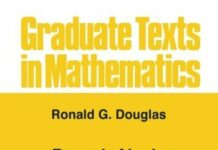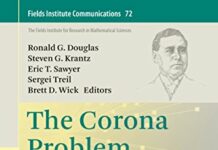
Ebook Info
- Published: 1998
- Number of pages: 214 pages
- Format: PDF
- File Size: 4.72 MB
- Authors: Ronald G. Douglas
Description
A discussion of certain advanced topics in operator theory, providing the necessary background while assuming only standard senior-first year graduate courses in general topology, measure theory, and algebra. Each chapter ends with source notes which suggest additional reading along with comments on who proved what and when, followed by a large number of problems of varying difficulty. This new edition will appeal to a whole new generation of students seeking an introduction to this topic.
User’s Reviews
Reviews from Amazon users which were colected at the time this book was published on the website:
⭐I posted the book back
⭐This book contains a lot of useful material, but it is a shame that there are a lot of typos.
⭐If this book is disappointing why did I rate it 5 stars? Well, it is because having studied the first edition I was expecting more updates in the second. It really is an excellent book, but I wanted the author to discuss the Brown-Douglas-Fillmore K-theory of operator algebras and give an in-depth discussion of the invariant subspace conjecture. I used this book for a two semester course in functional analysis and operator theory while a sophomore in undergraduate and found it very challenging. The presentation of the topics is very quick and the problems are pretty difficult, but you take away an appreciation of this important area of mathematics. Indeed, the theory of Hp-spaces and Toeplitz operators, which are covered in the last two chapters, have many applications in engineering and physics. The author does give an update on the problems he marked with two stars (indicating an unsolved problem) in the first edition, and references that discuss their solution. When studying the book, I am always amazed about how rich linear transformations become when they operate on infinite-dimensional Hilbert spaces; but also how much the finite-dimensional results have generalizations in infinite dimensions. The theory of C* and W*-algebras is discussed in the book, and the presentation should be helpful to physicists who use these techniques, even though the presentation is much more general than one would find in physical theories. The explanation of the W*-algebra as arising from the enlargement of the functional calculus to an algebra of functions generated by characteristic functions; where the Gelfand transform is taken on a larger commutative self-adjoint subalgebra of the space of linear operators is one that is easier to remember and seems more natural than merely giving a set of axioms that a W*-algebra is supposed to satisfy. A very abstract discussion of index theory is given, and one that is pretty distant from the theory of integral equations, but with some work one can see the connection to these equations. Who knows, maybe a third edition with more of the author’s insights?
Keywords
Free Download Banach Algebra Techniques in Operator Theory (Graduate Texts in Mathematics (179)) 2nd Edition in PDF format
Banach Algebra Techniques in Operator Theory (Graduate Texts in Mathematics (179)) 2nd Edition PDF Free Download
Download Banach Algebra Techniques in Operator Theory (Graduate Texts in Mathematics (179)) 2nd Edition 1998 PDF Free
Banach Algebra Techniques in Operator Theory (Graduate Texts in Mathematics (179)) 2nd Edition 1998 PDF Free Download
Download Banach Algebra Techniques in Operator Theory (Graduate Texts in Mathematics (179)) 2nd Edition PDF
Free Download Ebook Banach Algebra Techniques in Operator Theory (Graduate Texts in Mathematics (179)) 2nd Edition

